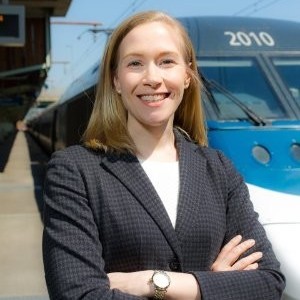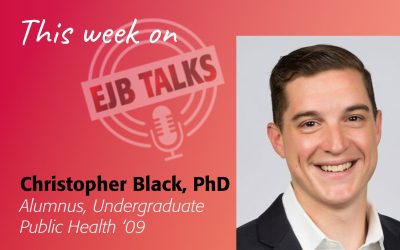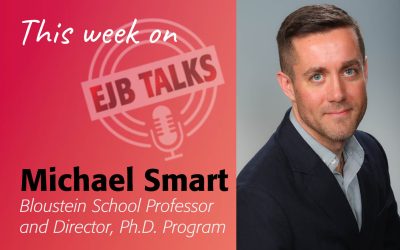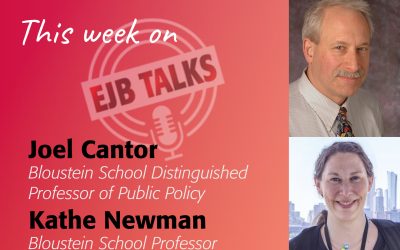For our last #EJBTalks episode of 2022 Stuart Shapiro talks with urban planning alum Gretchen Minneman Kostura MCRP ’07. They discuss her journey from a student focused on community development to her professional work in transportation. After starting her career in the Port Authority Leadership Fellows program, she moved to her current position working for the CEO and President of Amtrak. She talks about the current challenges and opportunities facing Amtrak, from aging equipment to what the recently passed infrastructure bill could mean for the Northeast Corridor and the rest of the country. Gretchen concludes with some great advice for Bloustein students and alums starting out on their professional careers in urban planning.
Stuart Shapiro
Welcome to EJBTalks. I’m Stuart Shapiro the Interim Dean of the Bloustein School, and the purpose of this podcast is to highlight the work my colleagues and this season particularly our alumni, in the fields of policy, planning, and health are doing.
This 30th anniversary year for Bloustein, we are focusing on our alums and the contributions they’re making here in the US and around the world. Today, we’re talking to one of the graduates from our world-ranked Urban Planning Program. Gretchen Minneman Kostura is a Senior Director at Amtrak. Welcome to the podcast, Gretchen.
Gretchen Minneman Kostura
Thank you, Stuart. I’m happy to be here with you and to share a little bit about Amtrak and what I’ve been doing since leaving Bloustein.
Stuart Shapiro
That’s great. I love Amtrak. I just made some more Amtrak reservations about an hour ago.
Gretchen Minneman Kostura
We love to hear that. Thank you. ((laughing))
Stuart Shapiro
((laughing)) It was not in preparation for this podcast, it was just because I needed to go to Washington.
So you’ve told me a little bit about how when you were at Bloustein, you were a community development person, that was what you studied? Can you tell me sort of how you got from there to Amtrak?
Gretchen Minneman Kostura
Sure. Yeah. So like you said, I focused on community development and sort of affordable housing at Bloustein. And also, my undergraduate degree is also in planning. And that always seemed to be where I was going to land. I ironically, only took one transportation course while at Bloustein. And my mom tried to push me to take more. And I said, No, I have no interest in transportation. And yet, here I am.
So I think when it came time to graduate, and there were a lot of, you know, job fairs and network events with people, recent graduates, and the Port Authority of New York and New Jersey has a strong connection to the Bloustein School and the Leadership Fellows program that the Port Authority has. And so you know, recent grads came back and talked about it, and I knew I was going to move to New York City once I graduated. And something about the program there, what the program really offered its fellows in terms of the ability to see and sort of touch and feel everything in this mega transportation organization. And that at the heart of the Port Authority’s mission, and also, you know, Amtrak’s mission and a lot of these large transportation agencies is really moving people to the places they need to go. Which, you know, I sort of justified in my mind linked back to community development.
And so I was at the Port Authority for a few years, did the Leadership Fellows Program, and then spent a few years after that program in the real estate department. And I focused a lot on planning and zoning studies, the highest and best use analysis for new developments we wanted to undertake. And I also oversaw the local assistance program, which provided planning and other types of services to organizations in the communities where the Port Authority had facilities.
So I sort of justified all of my actions and that I was still fulfilling this mission of community development just through a little bit of a different lens. And then, in 2013, my husband and I moved to Washington DC, and he took a new job down here. And that’s when I started working at Amtrak.
Stuart Shapiro
Gotcha. So one of the lessons sort of buried in there is that you really should always listen to our mothers, right?
Gretchen Minneman Kostura
She reminds me of that, yes. ((laughing))
Stuart Shapiro
((laughing)) I’m sure she does. And you could use that as a parable for your children. So tell us about the positions you’ve held at Amtrak.
Gretchen Minneman Kostura
Sure. So when I started at Amtrak in 2013, I started working on the Washington Union Station capital program. And it’s still ongoing. We have a series of near-term investments that we’re making to provide additional capacity, flexibility in our operations, and modernization to our facilities for our passengers and our crews. As well as overseen, at that point, it was a $10 billion station expansion project. But you know, escalation and COVID have driven that cost up. So I think the latest estimate is $15 billion station Expansion Project. This would really create a brand new neighborhood above the tracks in Washington DC, and sort of a total revamp and redo of what we know of as Washington Union Station today.
I oversaw that program for quite a few years, and then I moved to oversee what we call the “major stations portfolio” with Amtrak. And so Washington is one of our major stations along with New York Penn, Baltimore, Philadelphia, and Chicago. So I oversaw the teams at those stations doing the same type of capital planning, delivery, and project development that I did in Washington.
And then about six months ago, I transitioned to the position I’m in now, which as you mentioned, was Senior Director, Coordination and Special Projects in the Office of the CEO and President. And that has a lot to say, but in general, it is the Chief of Staff for our CEO, Steven Gardner, and our president, Roger Harris.
Stuart Shapiro
That’s great stuff, and definitely a lot of exciting things to be involved with. What are the biggest challenges facing Amtrak? Most of those stations you mentioned are right on the Northeast Corridor there, from Boston down to Washington, you pass through New York, Philly, Baltimore, and Washington. And that’s Amtrak’s busiest route. I know, I ride it all the time. What are the biggest challenges facing Amtrak and the Northeast Corridor.
Gretchen Minneman Kostura
Well, we have many. Some of our challenges I think, are no different than other industries right now, coming back from COVID. We definitely have a staffing shortage. So if you’ve ridden our trains, we do not have a ridership shortage, which is incredible.
Stuart Shapiro
Yeah, I noticed that.
Gretchen Minneman Kostura
We are almost back to pre-pandemic levels in terms of ridership, which, you know, we are thrilled to see, however, it is outpacing our capacity at the moment. So we still have lower levels of staffing, which across the board means we can’t run as many trains, and we don’t have as many people on the trains to support our passengers. We don’t have as many people in our mechanical department to get those trains on the railroad. So all of that, I think is a huge challenge for us still, and something that in 2023, we hope to really come back from.
Additionally, I mean, you’ve been in the corridor, so you know, it’s very old. A lot of our bridges and tunnels and other associated infrastructure is 100, maybe more than 100 years old. And so you know, running a modern railroad on antiquated equipment and antiquated infrastructure is definitely a challenge and slows us down in places.
And then I would say other than that, you know, we do have old equipment that we’re using. So one of the biggest things, I think, in 2023, you’re going to see is the new Acela fleet start to hit the Northeast Corridor, which we have been waiting for for a very long time. And we’re also in the process of modernizing and updating the design for the new regionals. The inner city train sets, which will be out within the next, I’m going to say few years. I’m not going to put a number to that one.
Stuart Shapiro
There you go. So with the personnel shortages, is that a is that what we’re seeing across the economy? Just they’re not enough people who are looking for the kind of work that you need to fill positions for? Or is it, you know, that there are other issues of play?
Gretchen Minneman Kostura
It’s a few issues. I mean, we did it was very public, that we furloughed people during the pandemic. So we just were down in numbers, and then to create that to fill that deficit and then build more. So we did hire. We hired more than 3700 new employees in 2022, which is incredible. I mean, that is like 10 times what we hire in a normal year, and we hope to hire more in 23. So we’re digging out of the hole, as well as trying to expand both in terms of our capital capacity, as well as our operational capacity.
Stuart Shapiro
It’s always, you know, we’ve heard talk about the expansion of passenger rail throughout this country for a long time, as long as I’ve been following public policy and those issues. Are there any prospects that we will see Amtrak operate elsewhere, the way it operates in the Northeast Corridor?
Gretchen Minneman Kostura
I’m not sure it will operate in the way it operates to the capacity. You know, there’s just as we know, and we study the statistical area, right, there’s just the density of people along the northeast corridor. But Amtrak was formed and the core to our mission is to be America’s railroad. And we really, you know, truly believe that that is what we need to be striving for. And, you know, we receive our money from Congress. And so they also want to make sure that we are the nation’s railroad and not just the Northeast Corridor railroad.
And there’s a lot that’s going to happen, I think, on the national network and the bipartisan infrastructure bill that was passed a year ago, a huge chunk of that is to work to expand rail access across the country. And there’s a program with the Federal Railroad Administration right now to sort of identify those areas that both have the demand and also the political will to want to work to build and plan for new routes.
So I don’t know if you’ve ever played the game Ticket to Ride, which is a railroad board game. But we play it at my house. And it is really like seeing the Ticket to Ride. You are building routes across the country and I just really like seeing it come to life here I think over the next few years.
Stuart Shapiro
Coincidentally, we went to a board game convention this past weekend, and, my older son won his preliminary Ticket to Ride match and made it to the finals before coming in second in the finals there. So we are a Ticket to Ride family.
Gretchen Minneman Kostura
Sounds like there’s a future for him and Amtrak, then. ((laughing))
Stuart Shapiro
((laughing)) I will let him know if this math thing doesn’t work out.
So you talked about the infrastructure bill, is there anything else in there besides the expansions that you talked about, that really will impact Amtrak? Or is that the focus of it?
Gretchen Minneman Kostura
Oh, no, that’s a part of it. And really, that’s, you know, the Federal Railroad Administration is going to lead the effort there in terms of the route expansion. But the infrastructure bill allows Amtrak to do capital work that we’ve just never had the money to do, basically. You know, it was $66 billion, although we always caveat that a lot of that is grant money. So we have to compete for that money, but just $66 billion for passenger rail is tremendous. And so when you go back to your previous question about, you know, not just becoming a Northeast Corridor railroad, but a national railroad, I mean, that’s at the heart of the infrastructure bill is giving money to rail and making, and showing that there is a huge demand and desire for rail in America, which I just think we haven’t had this type of enthusiasm in decades.
So to your initial question, yes, there’s a lot that this will allow us to do, it allows us to get to a lot of the backlog and deferred maintenance that we have, again, mostly along the northeast corridor, because that’s where we own most of the railroad. And it’ll allow us to do those huge infrastructure projects that I talked about in the beginning. You know, Gateway, obviously, everyone at Bloustein and in the New York, New Jersey area is very familiar with the need for additional capacity under the Hudson tunnels. There are also the East River tunnel projects. There’s the Connecticut River Bridge. There are the BMP tunnels. So there’s a lot that connects Washington to Boston, that this money will allow us to actually not just have a sort of like a dream, but you know, we’ve got planning, we’ve got procurements open right now to really start delivering on some of these. And all of that is really made available through the infrastructure bill.
Stuart Shapiro
That’s great. Here’s hoping that we really see the results of that in the next decade, as it unfurls.
Gretchen Minneman Kostura
I will say, Stuart, I’m glad you say decades because a lot of people are wondering why nothing’s happened. But it takes a long time. And we’ve been planning but you can’t move beyond planning until you know that money is going to be there. So it may be a decade, but changes are coming.
Stuart Shapiro
Yeah, years of experience have taught me to be modest in my expectations around timeframes, and even, for issues that don’t involve the expenditure of billions and billions of dollars. And so, I know there are a lot of implementation challenges that lie ahead.
And toward that end, sort of, can you talk a little bit about how you’re playing? You’ve used the word planning a fair number of times there. How did your planning education sort of how do you see it play out in your day-to-day work?
Gretchen Minneman Kostura
Yeah, I think the planning, and you can always tell when you’re working with like an engineer versus someone with a planning background versus someone with you know, I work with a lot of people that have finance degrees. And I think it’s valuable to have all at the table, but for a lot of what I’ve done at Amtrak, especially with the station’s, understanding and having a foundation in transit-oriented development and passenger experience and connecting the passenger to where they need to go, the urban round, you know, all those types of like, buzzwords, I think, really do matter.
And it gives you a perspective that we’re not just building a station, but we’re building a network that allows people to get to where they need to go. As well as in many of these locations, these stations sit in the heart of the city. So how do we plan and develop in and around the station to improve the lives of those that live there the lives of those that pass through there that work there, all of that? And I think having a planning, foundation and planning really help to inform all of that process.
Stuart Shapiro
That’s, that’s a great connection there. Now let’s sort of flip that question a little bit and think about our current planning students and those that will be entering next year, what advice would you give them?
Gretchen Minneman Kostura
Well, at the risk of having all of them reach out to me, I would say that you know, one of the benefits of Bloustein, especially, is that it is so recognizable within the Northeast Corridor, where a lot of students are probably looking to locate once they’re done. And there’s a huge network of alumni. And, you know, I think we’ve all gotten to where we’ve gotten to because of the support of previous alumni. And so I really, you know, if there’s someone that does something you’re interested in, reach out to them.
That’s how I ended up at the Port Authority. I talked to the person who was in the Leadership Fellow Program, who graduated the year before I did, and, you know, he really sold it to me. And so I think that one of the huge benefits that all the students and young alumni have is that there’s so many of us out there. And I think we all are willing to, to take time to help educate on opportunities.
Stuart Shapiro
That is a fantastic wrap-up to this season, actually, because our theme has been all the wonderful things our alumni are doing. And one of the reasons we wanted to highlight it, in addition to giving our platform to great alums like Gretchen, was to let students know that you know, there are a wide variety of career possibilities for people coming out of the Bloustein School. And there’s a network out there that can help you think about whether those careers are right for you. So I didn’t know that you would say that at the end, but boy did you wrap things up in a way I could only have dreamed about there.
Thanks so much for coming on the podcast Gretchen.
Gretchen Minneman Kostura
Thank you so much, Stuart. I appreciate it.
Stuart Shapiro
A big thanks to Amy Cobb and Karyn Olsen, our production team as well. We will be off for the holidays after this episode. And then we will be back next season we are going to focus on our new faculty members and there are a lot of them. So we’ve got some exciting episodes next season for you.
Have a wonderful holiday season and stay safe.




